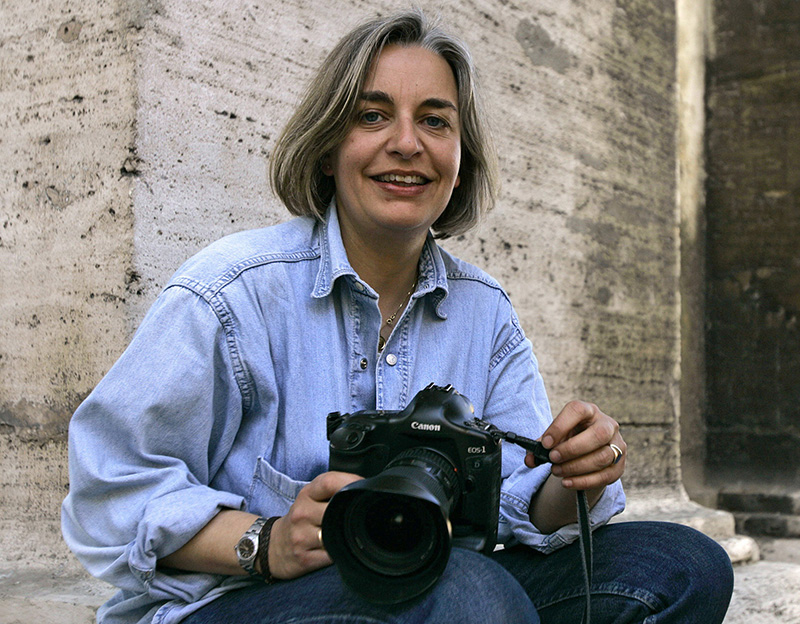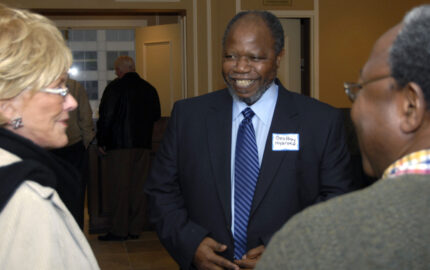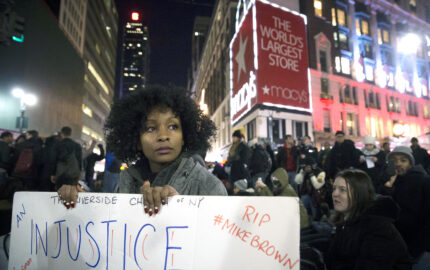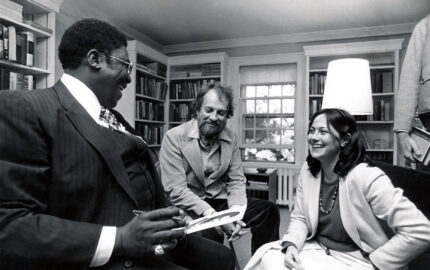Anja Niedringhaus, who was killed April 4 while covering election preparations in Afghanistan, had photographed wars and conflicts for two decades. In 2005, the Associated Press photographer shared a Pulitzer Prize for Breaking News Photography for coverage of the war in Iraq. “Conflict is not all that I cover,” she wrote in Nieman Reports. “I like the Olympics and the World Cup. In sports, there is a start and a finish. With war, the story never ends. It keeps me coming back.” The 2007 Nieman Fellow is fondly remembered by her Nieman classmates and colleagues.
See Anja's Work:
- “Common Ground” from Nieman Reports's Spring 2012 issue
- “Emotions Speak Through Images” from Nieman Report's Summer 2007 issue
- “Remembering Anja Niedringhaus” from Nieman Storyboard
- “Afghanistan: Seen Through the Lens of Anja Niedringhaus” from The Atlantic's “In Focus” blog
- “Portraits of Afghanistan's Female Lawmakers” from Al Jazeera America
- Watch a video discussion about reporting risks in Afghanistan
Stefanie C. Friedhoff
2001 Nieman Fellow, assistant director for programming and special projects, Nieman Foundation
“Da nech für” is how people in Hamburg, Germany, say “You’re welcome.” When I said it to Anja Niedringhaus in the kitchen of Walter Lippmann House during one of her first weeks on the fellowship, she responded, in German, her voice full of mischief: “Uh, Stefanie, don’t pretend you’re not a pasture-loving, thick-headed Westphalian!” And her radiant laugh echoed through the house.
Hamburg, you must know, is occupied by worldly people. Westphalia has a lot of, well, farms. I joined her laugh, and I swear we both felt a little lighter, a little freer that day, and many days after while Anja was in Cambridge and we had time to talk, argue, tease. Two Germans, two Westphalians even (albeit from different parts of the state) enjoying the familiarity of a shared history that was conveniently far away.
Throughout her Nieman year—when Anja studied everything from politics to music to literature but not so much photography, which she tried to take a break from—Anja never missed an opportunity to joke in German. Our common language became a bond in the Nieman diaspora in ways it never could in earlier years when we were still based in Germany, our paths crossing every once in a while on a breaking story.
With her unmistakable humor and down-to-earth practicality, Anja was easily the most resilient conflict journalist I know. She knew capturing how war and conflict impact people is important work. Someone had to do it so why not she. No posture, no pretense, no adrenaline seeking. (“I could be bungee jumping all day,” she’d respond to anyone suggesting that.)
Anja needed none of the advice we usually share at Nieman with journalists who cover conflict, such as: make sure you take good care of yourself; talk to your friends and family often; try to eat and sleep well. For her Sounding, Anja had brought her mom over all the way from her hometown of Hoexter to cook for her, to nourish her Nieman class. On her last night in Kabul, Anja made kartoffeln and würstchen and spend the evening with her friends and colleagues.
Anja’s stunningly straightforward commitment to journalism, and what really matters in this world, has always been humbling. Knowing her has helped me refocus many times. And her work, to me, wasn’t so much war photography as an ongoing study of resilience: For every tear Anja captured there was a smile. For every lost life she witnessed, she chronicled a life vividly lived amidst the rubble.
It is obvious from the outcry that followed the news of her death how Anja’s gift, and the gift of Anja, has touched so many around the world. So much so that in our disbelief, we exchange Facebook notes with strangers, celebrating her work, her kindness, her commitment, her great sense of humor. It is as if in her death, she is still creating community, and spreading resilience. And yes, she’d roll her eyes at such a suggestion and say: Let’s get on with it, shall we?
Cameron McWhirter
2007 Nieman Fellow, reporter, The Wall Street Journal
Our Nieman class, arriving in the fall of 2006, had a contingent of journalists who came to leafy, placid Cambridge from covering Iraq and Afghanistan.
For them, the year was in large part about getting distance from war. Not having to wear a helmet. Walking down a street listening for… nothing. A passing car was just a passing car.
Anja worked hard to get her time in Cambridge, to be free—at least for a short while—from worry and horrors.
She was by no means soft spoken, as anyone who knew her can testify. She laughed loudly. She used the term “scheiße” liberally, as well as earthy English equivalents. She thought deeply about journalism and liked to debate its future, changing nature, and ethical problems. She loved hearing stories and telling them.
But she had a quiet in her too, a sadness. She carried it well, but it was always with her, floating around.
You can see it in so many of her photographs—her eyes picking out quiet moments in war’s chaos. One of my favorites, in her second book, “At War,” is of a German soldier sitting forlornly next to lighted candles at dawn while on patrol in Afghanistan. He was celebrating his 34th birthday. And children. There are lots of children in her photos, innocents wandering in the midst of violence. …
Santiago Lyon
2004 Nieman Fellow, director of photography, Associated Press
It is a grim day for our profession and the AP family today as we mourn the loss of Anja Niedringhaus, shot dead in Afghanistan by a uniformed gunman. Reporter Kathy Gannon was wounded in the same attack and is in stable condition after undergoing surgery.
Anja was one of the most talented, bravest and accomplished photojournalists of her generation.
Her storytelling skill with a camera was extraordinarily effective, a reflection of her own open gaze and genuine compassion for her subjects.
Her enthusiasm and good cheer were infectious, even in the darkest of circumstances. She consistently volunteered for the hardest assignments and was remarkably resilient in carrying them out time after time. She truly believed in the need to bear witness.
To counterbalance those tough assignments though, Anja made a point of being a regular fixture at the world's top sporting events. It was not unusual to see her cabling multiple cameras together in order to capture world athletic records being smashed, or major tennis tournaments won.
She was a real all-rounder and was well recognized for her myriad accomplishments: she was a Pulitzer Prize winner, a recipient of the International Women’s Media Foundation Courage in Journalism Award, a Nieman Fellow and a World Press Photo jury member. She also published a book of her work titled "At War"—with an accompanying exhibition.
A great many people met, worked with and appreciated Anja over the years—she was universally liked and respected.
Personally, after 22 years of knowing and working with her in a variety of capacities, it is her wonderful images, her open smile and contagious laugh that will remain with me long after her life was taken today, so senselessly and unnecessarily.
On April 12, Lyon and AP executive editor Kathleen Carroll spoke at Anja's funeral in Hoexter, Germany.
Parish priest Bernd Mueller also read a letter from AP reporter Kathy Gannon, who was injured in the attack that killed Anja.
Carlotta Gall
2012 Nieman Fellow, Afghanistan correspondent for The New York Times, 2001 - 2013
Horrified to hear Anja Niedringhaus killed and Kathy Gannon wounded. Just spent 3 days of laughter and reporting with them in Kabul. RIP
— Carlotta Gall (@carlottagall) April 4, 2014
We Were Just Laughing: Days With Anja Niedringhaus and Kathy Gannon on The New York Times “At War” blog
Bob Giles
Nieman Foundation curator, 2000-2011
Anja was incomparable. She infused her Nieman class with a joy of life, affection for one another and a professionalism we admired. During her Sounding she shared one astonishing image after another, so many of them the result of fearless instincts that put her in harm's way to tell the story. She continued this courageous work in the time following her Nieman year. In countless violent encounters, she captured the tragedy of the victims as well as dramatic images of the chaos of combat.
Anja had such a warm heart and could light up a room with a laugh that seemed both hearty and naughty. In the international environment at Lippmann House, she was comfortable being German while thriving in a new culture.
As I write this, I am looking at an elegant Celadon vase Anja gave Nancy and me to celebrate her Nieman year and the friendship we enjoyed. Her mother had come from Germany for a visit and brought this small treasure from the family home. I cherish my memories of her and our happy time together. The wave of grief I feel is rolling through more than the class of 2007; her loss will be deeply felt by all who knew and loved her.
Christine Kaye
Nieman Foundation events planner
Anja may have been one of the funniest people I ever met. I laugh whenever I think of her. There was joy, and a hint of mischief, in the way she approached things.
I met her on the first day of orientation of her Nieman year. The group had been on a boat ride in the evening on the Charles River. After the event, Anja came into the house with a story that had us in tears we were laughing so hard. She had ridden her bike through Harvard Square and had gotten into an absurd and hysterical fight with a truck driver. She went on a 20 minute good-natured rant asking, "Is this really what it's like to ride a bicycle in Cambridge?!?" You would think it was the craziest, most dangerous thing she had ever done (which, of course, it wasn’t).



